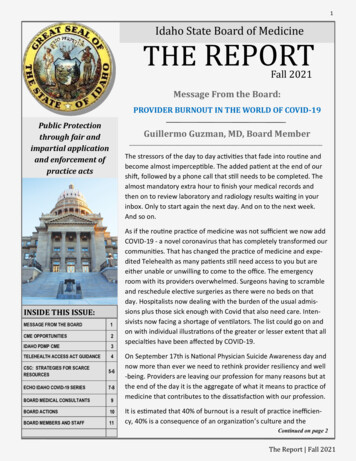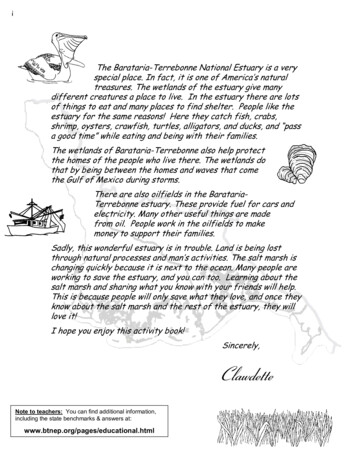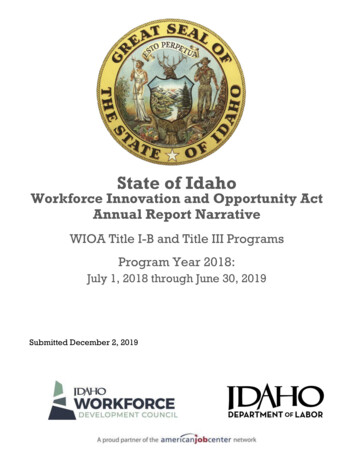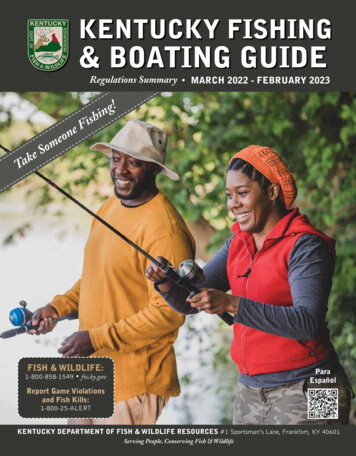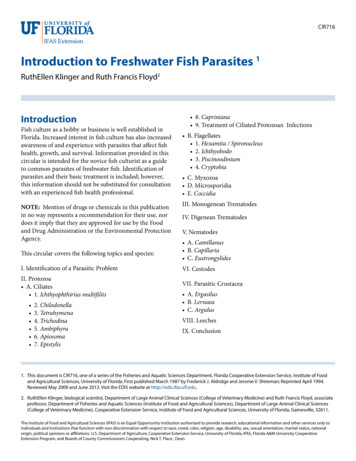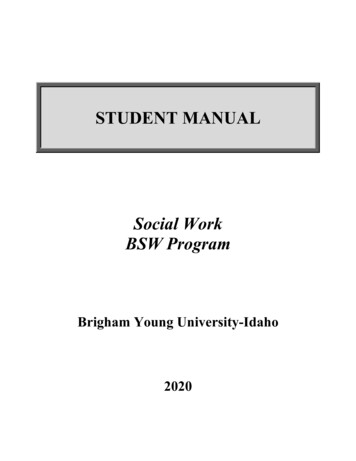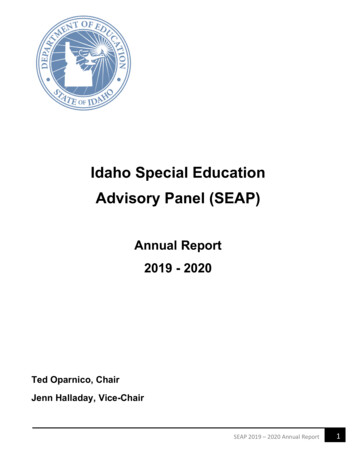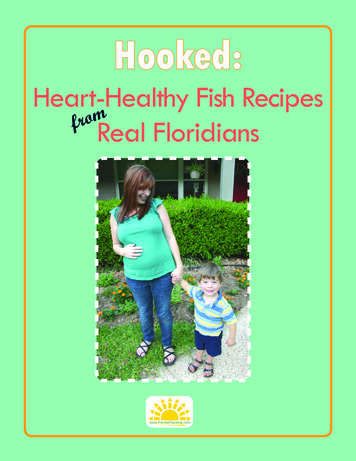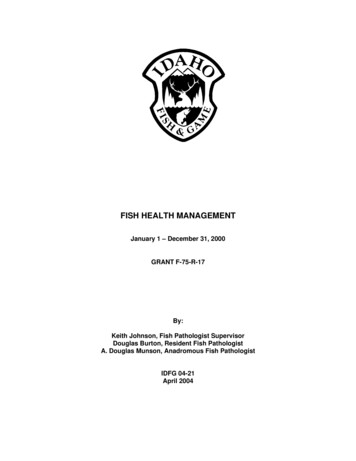
Transcription
FISH HEALTH MANAGEMENTJanuary 1 – December 31, 2000GRANT F-75-R-17By:Keith Johnson, Fish Pathologist SupervisorDouglas Burton, Resident Fish PathologistA. Douglas Munson, Anadromous Fish PathologistIDFG 04-21April 2004
TABLE OF CONTENTSPageABSTRACT. 1PERIOD COVERED BY THIS REPORT. 2FISH HEALTH MONITORING AND MANAGEMENT ACTIVITIES OF IDAHODEPARTMENT OF FISH AND GAME . 2Resident Hatchery Activities . 2American Falls Hatchery . 2Ashton Hatchery . 2Cabinet Gorge Hatchery. 3Clark Fork Hatchery . 3Clearwater Hatchery Resident Program. 4Grace Hatchery . 4Hagerman State Hatchery . 4Hayspur Hatchery. 5Henrys Lake Hatchery . 5Mackay Hatchery. 6McCall Hatchery Resident Program . 6Nampa Hatchery. 6Sandpoint Hatchery . 7Anadromous Hatcheries. 7Clearwater Hatchery and Crooked River, Powell and Red RiverSatellite Facilities. 7Clearwater Hatchery . 7Crooked River Satellite Facility. 7Powell Satellite Facility . 8Red River Satellite Facility. 8Magic Valley Hatchery. 8McCall Hatchery . 8Niagara Springs Hatchery . 9Oxbow Hatchery . 9Pahsimeroi Hatchery . 9Rapid River Hatchery . 10Sawtooth Hatchery . 10Sockeye And Chinook Captive Broodstock. 10Redfish Lake Sockeye Salmon Captive Broodstock . 11Salmon River Chinook Captive Rearing Program . 12i
TABLE OF CONTENTS (Continued)PageIDAHO WILD FISH SURVEY. 12TRANSPORTATION AND IMPORT PERMITS . 13REPORTS AND PRESENTATIONS. 13PRODUCTION STUDIES AND SURVEYS TO ENHANCE FISH HEALTH. 14RECOMMENDATIONS. 14ACKNOWLEDGEMENTS . 16APPENDICES. 17Appendix 1.Fish Health Summary Report, 2000 . 18Appendix 2.Geographic Location of Idaho Department of Fish and GameCulture Facilities. 40ii
State of:IdahoProject:F-75-R-17Name: FISH HEALTH ADMINISTRATIONPeriod Covered: January 1-December 31, 2000ABSTRACTThis report contains a description of the activities of the Eagle Fish Health Laboratory(EFHL), operated by the Idaho Department of Fish and Game (Department), for the calendar year2000. The primary charge of this program is to monitor, inspect, and improve the health of fishraised at 11 resident hatcheries, 11 anadromous hatcheries and satellites, and Eagle Hatchery,which rears Endangered Species Act-listed salmon captive broodstocks. Results of thesediagnostic cases are presented in the text by program and facility. The most significant diseasesencountered in the resident and anadromous programs were bacterial coldwater disease, bacterialkidney disease, infectious hematopoietic necrosis virus, furunculosis, and bacterial gill disease.Bacterial kidney disease also caused considerable loss in one group of chinook captive broodstock.Mortality in groups of Lemhi River chinook captives due to infestations with the copepod parasiteSalmonicola californiensis was controlled with a combination of manual removal and gastricintubation of Ivermectin. The Department fisheries managers, researchers, hatcheries, and EFHLpathologists utilized the wet laboratory during the year.Wild salmonids from five of seven regions of the state were examined for the parasiteMyxobolus cerebralis, the causative agent of whirling disease. The only new detections of whirlingdisease this year were from tributaries of drainages determined to be positive in prior years. Weinitiated research to determine the seasonal infectivity of M. cerebralis in the river water supplies ofboth Sawtooth and Pahsimeroi hatcheries. The staffs of both the EFHL and Eagle Hatcherysupported this research.The EFHL staff remained active participants in regional and national fish health issues. Thisincluded administering the Investigational New Animal Drug (INAD) program through the UnitedStates Fish and Wildlife Service (USFWS) and the University of Idaho. Examples of additionalliaison activities are included in the text.Authors:Keith JohnsonFish Pathologist SupervisorDouglas BurtonResident Fish PathologistA. Douglas MunsonAnadromous Fish Pathologist1
PERIOD COVERED BY THIS REPORTThis report covers activities for grant F-75-R-17 Federal Aid in Fish Restoration January 1 toDecember 31, 2000 by the Idaho Department of Fish and Game (Department).FISH HEALTH MONITORING AND MANAGEMENT ACTIVITIES OFTHE IDAHO DEPARTMENT OF FISH AND GAMEResident Hatchery ActivitiesThe Resident Hatchery Pathologist (RHP) provides service for hatcheries that rear andstock resident (non-anadromous) fish species. The RHP’s duties include collection of samples fromdiagnostic and inspection cases for 11 resident facilities plus 2 anadromous hatcheries withresident programs and their associated captive and feral broodstocks, monitoring laboratory results,reporting results to hatchery management, recommending and supervising treatments, andpreparing and maintaining files for Investigational New Animal Drug (INAD) reporting for eachstation. Samples were also obtained as part of a survey of wild salmonids of Idaho waters. Incalendar year 2000, these activities included 22 laboratory accessions for the wild fish survey, 42diagnostics, 27 routine hatchery inspections, and 17 inspections of feral broodstocks for theresident program. The results for these cases are included in Appendix 1 and are listed byDepartment region and for each fish culture facility. A brief summary of those results and activitiesfor each resident station are as follows.American Falls HatcheryBacterial coldwater disease (CWD), caused by Flavobacterium psychrophilum, wasdiagnosed in five lots of rainbow trout Oncorhynchus mykiss, and was the only significant diseaseproblem at American Falls in 2000. These were the first significant epizootics of CWD in fourproduction years. Low densities and reduced stress were the factors credited during the threeprevious years of no clinical CWD, but this year’s losses were observed in lots of fish held atextremely low densities. The fish were successfully treated with Oxytetracycline (OTC) at thestandard label dose and duration under INAD protocols. Prior to the epizootic-free years, it wasbecoming necessary to use higher doses and longer treatment duration for the same result. Thesegood responses indicate that the trend toward antibacterial resistance at this hatchery may havebeen reversed by three years of drug abstinence.Catchable-size groups of rainbow were inspected for pathogens and evaluated using anorganosomatic index to provide baseline data for the second year of a research study comparingthe return to creel of fish from three Department hatcheries (also see Hagerman State Hatchery andNampa Hatchery). A carrier state of F. psychrophilum was the only significant pathogen detectedin these groups.2
Ashton HatcheryNo significant clinical disease episodes occurred at Ashton Hatchery in 2000. Populationsof rainbow trout and cutthroat trout O. clarki fingerling were sampled for routine inspections. Noreplicating viruses, bacteria, or Myxobolus spores were detected from either population. Thehatchery manager reported that the monogenetic trematode Gyrodactylus continues to be a chronicproblem, but did not cause mortalities great enough to treat.Ashton Hatchery continues to be at risk for contamination by Myxobolus cerebralis (MC),the causative agent of salmonid whirling disease. As more natural waters in the vicinity are shownto be positive for the parasite, there is increased probability that the uncovered portions of thespring and stream above the hatchery intake will become contaminated.Cabinet Gorge HatcheryThe RHP visited Cabinet Gorge Hatchery twice in 2000, once in May to diagnose losses inproduction kokanee salmon O. nerka kennerlyi, and again in December to inspect spawningkokanee adults at the Sullivan Springs trap. So few fish returned to the Clark Fork River trap thatno samples were taken this year. Bacterial gill disease was the diagnosis in May, and the fish weresuccessfully treated with a combination of Chloramine-T (under an INAD protocol), densityreduction, and changes in feed type and regimen. The condition of spawning adults at SullivanSprings appeared very good, with an observed occurrence of encysted cestodes in the pyloriccecae and nematodes in the swim bladder similar to past years. There have never been any grosssigns indicating that these parasites cause significant adverse effects on the fish. Historically,Renibacterium salmoninarum (RS) antigen has been detected in this population using the enzymelinked immunosorbent assay (ELISA), but the presence of viable organisms has never beendemonstrated by the fluorescent antibody test (FAT). Only FAT was used this year due to ashortage of good reagents for ELISA at EFHL. No RS organisms, the causative agents of bacterialkidney disease (BKD), were detected.Clark Fork HatcheryWestslope cutthroat juveniles at Clark Fork Hatchery were sampled in February 2000. Amixed bacterial infection of Flavobacterium, Aeromonas, and Pseudomonas species wasdiagnosed. The fish were treated with OTC-medicated feed under the existing label. No other fishwere sampled during the course of the year.Due to the combined factors of fiscal constraints, pathogens carried by feral fish in the mainwater supply, and very cold water temperatures that lead to poor growth rates, it was decided toclose down operation of Clark Fork Hatchery. The last production fish reared on-station werestocked out during the summer of 2000. The future of fish production on the facility is uncertain, butmay be limited to natural kokanee spawning in gravel channels.3
Clearwater Hatchery Resident ProgramTwo diagnostic examinations were conducted on the same lot of Hayspur-strain rainbowtrout (R9) at Clearwater Hatchery. The first sample, taken June 5, detected Aeromonas hydrophila,the causative agent of motile aeromonad septicemia (MAS). No treatment was applied. Thesecond sample, taken seven weeks later, detected F. psychrophilum. Oxytetracycline (OTC) wasapplied in medicated feed under an INAD protocol at standard dosage. Success was limited atbest. The isolate of F. psychrophilum should have been susceptible to the drug, as indicated by invitro tests, but the possibility of a mixed infection could explain the poor response. Historically,rainbow trout have not responded well to treatment at this hatchery. Better success might beachieved at the next similar episode by treating earlier with a higher dosage and longer duration.Grace HatcheryNo significant clinical disease or fish losses occurred at Grace Hatchery in 2000. Thehatchery was visited once in November to inspect fingerling-size rainbow trout. No replicatingviruses or Myxobolus spores were detected, but a carrier state of F. psychrophilum was detected.Production was significantly reduced at Grace for much of the year due to reconstruction of thespring collection facilities and pipelines. Covering the main springs and the open ditch from thesprings to the hatchery should significantly reduce the chance of pathogen introduction by wildlifevectors. The remaining, short section of open ditch and the open middle springs mean that thechance has not been completely eliminated.Hagerman State HatcheryA total of 26 diagnostic and 4 inspection cases were examined from Hagerman State FishHatchery in 2000 (compared to 21 and 2 in 1999). Losses among rainbow/Kamloops lots in theoutside raceways frequently involved a combination of pathogens. Infectious hematopoieticnecrosis virus (IHNV) was detected nine times, often in combination with one or more bacterialpathogens (F. psychrophilum, F. columnare, A. hydrophila, or A. sobria). The hatchery personnelobserved several additional IHN episodes without calling on the EFHL for diagnostic confirmation.Several bacterial infections, primarily CWD and MAS, were diagnosed without the complication ofvirus. These episodes were treated with OTC-medicated feed, using the existing label or an INADprotocol, whichever was appropriate for the situation. Most of the treatments were successful. Thenumber of INAD protocols to treat CWD was greatly increased in 2000.Aeromonas salmonicida, the causative bacteria of furunculosis, was again detected atHagerman in 2000. This pathogen was first detected at Hagerman in 1998, but not in 1999. Theepizootic was treated successfully with Romet-30 incorporated in feed, under the existing label forthe drug.Catchable-size Kamloops rainbow trout on both the Riley Creek and Tucker Springs watersources were inspected for pathogens and evaluated using an organosomatic index to providebaseline data for Douglas Megargle’s research study comparing the return to creel of fish fromthree Department hatcheries (also see American Falls Hatchery and Nampa Hatchery). Carrierlevels of Aeromonas/Pseudomonas bacteria were the only pathogens detected in those fish.4
Hayspur HatcheryThe RHP’s work at Hayspur Hatchery involved considerable effort to inspect brood stockand brood stock replacement lots. The brood year 1998 (BY98) replacement rainbow (R9) andKamloops (K1) populations were inspected in August and September. No viruses, Myxobolusspores, or significant bacteria were detected. In previous years, similar populations of fish havetested positive for RS antigen at low levels by ELISA, although clinical BKD has never beenobserved on this station. Due to a critical shortage of good ELISA reagents at EFHL, this year’sfish were tested by FAT only. No RS was detected by FAT.All BY99 replacement R9s and K1s were given a bath vaccination at 1.0 to 7.2 grams insize, using an autogenous F. psychrophilum bacterin. In addition, half of the R9s received abooster bath about five months later. The bacterin was produced by AquaHealth Ltd.,Charlottetown, P.E.I., Canada from a bacterial isolate taken at Hayspur in 1998. None of the fishhave shown signs of bacterial disease to date, and mortalities have been minimal. Since therewere no control fish available, the benefit of the treatment is unproven. However, this is a directionfor CWD-control that will receive much more effort in the future.The major focus of the pathologist’s work at Hayspur Hatchery was inspection of the broodpopulations. During the 2000 calendar year, a total of 328 female R9 and K1 brood fish were testedfor viruses (ovarian fluids), and RS by ovarian fluid cell pellet fluorescent antibody test (OCP-FAT).In addition, 109 of the same females were sacrificed for kidney ELISA samples and tissue virology.No viruses were detected from any samples. Fluorescing organisms were detected by OCP-FATfrom five of the R9 fishes and from none of the K1 fishes. There was some question about the fivepositive OCP-FAT results from the R9 population, because some of the organisms were of size andmorphology consistent with RS but others were slightly larger. Samples from the same individualswere all negative by ELISA, which is generally considered to be the more sensitive of the two tests.This group of results may have been due to the presence of cross-reacting bacteria species, suchas P. fluorescens, instead of RS. Because the evidence was not conclusive, and in order to stayconsistent with established protocol, eggs from those fish were culled from the replacementprogram. ELISA detected RS antigen in kidney samples from 3 of 60 R9 and in 18 of 49 K1 fishes.Eggs from the females with an ELISA optical density above 0.110 were culled from the replacementbroodstock lots.Henrys Lake HatcheryFish health inspection samples were taken from spawning Yellowstone cutthroat O. clarkibouvieri at Henrys Lake Hatchery from March 6 through April 27, 2000. Ovarian fluids werecollected by hatchery personnel and shipped to the EFHL where they were tested for viruses (280females in 40 seven-fish pools) and RS by OCP-FAT (1,307 females in 165 seven-fish pools, 22six-fish pools, and 20 individual samples). A group of 60 fish (both males and females) weresacrificed for kidney FAT, tissue virology, bacteriology (16 fish) and Myxobolus tests. SummerMacey, an Albertson’s College of Idaho student, assisted in taking the samples as a part of hersenior project. No viruses were detected in any of the tissue or ovarian fluid samples. Two pools ofovarian fluids tested positive for RS by OCP-FAT, and eggs from those pools were discarded. All ofthe kidney FAT samples were negative. Bacteriology samples showed carrier-level infections of F.psychrophilum from 5 of 16 fish, and P. fluorescens from two fish. No other bacterial pathogenswere detected. M. cerebralis spores were detected in 9 of 12 pools of five fish each. This is of5
concern in that the prevalence of the parasite in the population seems to be increasing. Clinicalsigns of whirling disease, primarily dished and shortened craniums, were observed.Mackay HatcheryNo significant clinical disease or fish losses occurred at Mackay Hatchery in 2000. The RFPvisited the hatchery twice during the year, sampling fingerling kokanee and rainbow trout in June,and fingerling Henrys Lake cutthroat in September. No replicating viruses, RS, or Myxobolusspores were detected. The only pathogen detected was a carrier state of P. fluorescens bacteria inthe rainbow trout. The hatchery remains at risk from contamination from MC, due to the very closeproximity of positive fish in the outflow stream and settling pond. The probability of detecting suchcontamination is extremely low due to the design of the hatchery and the likely low levels ofprevalence and intensity.Mackay Hatchery received green eggs from the early-spawning kokanee in DeadwoodReservoir. The spawning population was inspected on September 1. No viruses or Myxobolusspores were detected in samples from 69 fish. Sixty fish were tested by the FAT method and no RSbacteria were detected. Due to the shortage of good ELISA reagents at the laboratory, only threepools (x3) of these adults were tested by this method. All three pools were positive for RS antigenat very low levels, which is consistent with the history of this population.McCall Hatchery Resident ProgramThe Westslope cutthroat trout run at Fish Lake was again so low in 2000 that no sampleswere taken. It is likely that this program will be discontinued. As a replacement source of cutthroatfor the high mountain lake program, eggs were purchased from a certified significant pathogen-freeprivate hatchery in Montana. Fry from these eggs began to experience elevated mortality within 710 days after swim-up due to CWD. The fish were treated with OTC-medicated feed under anINAD protocol with very good response.Nampa HatcheryBacterial CWD and MAS, primarily A. hydrophila or A. sobria, continue to be the mostcommon diseases diagnosed in rainbow trout at Nampa Hatchery. Outbreaks of MAS in Hayspurrainbow reared in the small “A” raceways were frequent in the spring and early summer. Thehatchery was at full production, and heavy loading may have been a contributing factor to theseepisodes. Treatments with OTC-medicated feed on the existing label were moderately successful,at best. Two episodes of CWD were treated under INAD protocols with better success.Catchable-size Kamloops rainbow trout were inspected for pathogens and were evaluatedusing an organosomatic index. This was done to provide baseline data for Douglas Megargle’sresearch study comparing the return to creel of fish from three Department hatcheries (also seeAmerican Falls Hatchery and Hagerman State Hatchery). A carrier state of F. psychrophilum wasdetected in one of these fish.6
Sandpoint HatcherySandpoint Hatchery was closed in 1999 and has not been in fish production since. Thisclosure is expected to be permanent. If so, this will be the last mention of this facility in this report.Anadromous HatcheriesThe Department anadromous hatchery facilities and associated satellite adult capture andrelease stations for steelhead O. mykiss and chinook O. tshawytscha are funded through LowerSnake River Compensation Plan (LSRCP) and Idaho Power Company (IPC). The anadromouspathologist (AFP) provides diagnostic and inspection services for chinook, sockeye, and steelheadthat are spawned, reared and released from Department facilities. The AFP also cooperates withother state, private, federal, and tribal programs that could impact Idaho’s fishery resource. Thecalendar year 2000 summary of results for the hatcheries and satellite stations is presented inAppendix 1 and totaled 181 inspection and diagnostic cases that were processed by the EFHLpersonnel. The following is a summary of that work and sample results.Clearwater Hatchery and Crooked River, Powell, and Red River Satellite FacilitiesClearwater HatcheryThe Clearwater Hatchery is the main facility in a complex that produces steelhead andchinook in conjunction with Crooked River, Powell, and Red River satellite facilities. DworshakNational Fish Hatchery (DNFH) provides steelhead eggs for Clearwater’s steelhead program. Atotal of 23 inspection and diagnostic cases were attributed Clearwater Hatchery. Three moreinspection cases were performed on samples collected from brood steelhead at Dworshak NationalFish Hatchery. In 2000, only the B strain steelhead suffered losses to an etiologic agent (F.psychrophilum). An application of OTC-medicated feed, stopped mortalities. Infectioushematopoietic necrosis virus (INHV) was isolated in B strain female steelhead brood fish atDworshak National Fish Hatchery. The eggs from these positive fish were not transferred toClearwater Hatchery. Adult chinook were transported from Red River and Crooked River (SouthFork of the Clearwater spring chinook) and spawned at Clearwater Hatchery. All 376 females wereexamined for RS by ELISA. All but two females were found to be positive (optical densities aboveor equal to 0.100).Crooked River Satellite FacilityAt this satellite of the Clearwater Hatchery, fall and spring inspections were applied toacclimating chinook prior to their release. The only pathogen detected in these two preliberationsamples was RS via ELISA examination, (8 of 8 five-fish pools were positive, all at low opticaldensities). No viral replicating agents or Myxobolus spores were detected. A total of 40 juvenilechinook were examined (20 per inspection).7
Powell Satellite FacilityJuvenile fish were not reared at this facility during 2000. Spring releases of Powell juvenilechinook were examined for preliberation survey. These fish were pathogen free except for ELISAtesting for RS that demonstrated two of four pools positive at low optical densities.All other inspection cases at this satellite were of spawned brood chinook salmon. Routineviral examination of ovarian fluids detected IHNV in brood chinook during spawning. No Myxobolusspores were found at this facility in any of the fish health examinations. Renibacterium antigen wasfound by ELISA in 582 female chinook at spawning with only 24 having optical densities lessthan 0.1.Red River Satellite FacilityChinook salmon juveniles were not reared at this facility during 2000 due to the historic highmortality from Ichthyophthirius multifilis infestations that occurs here. A short acclimation period inthe fall when water temperatures are low is used for fall-released juveniles. No pathogens weredetected during fall and spring preliberation sampling, with the exception of low levels of RS antigenby ELISA.Magic Valley HatcheryDworshak, East Fork, Pahsimeroi, and Sawtooth steelhead stocks required nine inspectioncases and four diagnostic cases during 2000 at the Magic Valley Hatchery. In each of the fourdiagnostic trips, F. psychrophilum was found to be the etiologic agent. Mortalities were highenough to warrant medicated feed treatment, and were controlled with OTC-medicated feedapplications under INAD # 9332 protocols.The organosomatic index, done at preliberation exams, demonstrated very robust fish, withplenty of stored energy. No replicating viruses, furunculosis or MC were detected at Magic ValleyHatchery in 2000. To curtail any chance of horizontal transmission of etiologic agents a stringent,annual disinfection program has been applied to this facility.McCall HatcheryTwenty-two inspection cases were performed for McCall Hatchery and South Fork Trap.These included 10 inspection cases performed on Johnson Creek juveniles and brood fish for theNez Perce Tribe (NPT) Fisheries Program. No serious pathogens were detected in McCallHatchery juvenile chinook during this calendar year. Preliberation testing by ELISA found lowoptical densities for RS antigen in one of four pools sampled in the BY98 Johnson Creek chinookand four of four low optical density pools in BY98 South Fork Summer chinook. Two prophylactictreatments of Erythromycin medicated feed for 28 days each in June and September were appliedto all juvenile chinook at this facility using INAD 6013/4333. An extra vitamin pack (“EIBS-fortifieddiet” from Bio-Oregon) was added to the normal feed ration and has eliminated spring mortality atthis facility.8
The South Fork Trap, a satellite facility of the McCall Hatchery, had 16 accessions loggedinto the EFHL during 2000. Brood summer chinook salmon from the South Fork Salmon River andJohnson Creek were examined for RS, MC, and viral replicating agents. No Myxobolus spores orviral replicating agents were detected. All spawned females were tested by ELISA, and opticaldensity data was used to select the eggs to be culled. Egg lots from high optical density femalesrepresent the greatest risk for horizontal transmission of RS. Therefore, egg lots from females thatmeasured ( 0.25) optical density were culled from the hatchery program. The EFHL is able tomake a culling or segregation program to fit the needs of each Department chinook hatchery.Niagara Springs HatcheryEleven inspection cases and one diagnostic case originated from Niagara Springs Hatcheryduring 2000. Hells Canyon and Pahsimeroi steelhead stocks were examined; Pseudomonas and F.psychrophilum were responsible for most mortalities. Future work should focus on inventorymanipulations to maintain densities below stressful levels and to manage around opportunisticpathogens such as Flavobacterium.Oxbow HatcherySix inspections were made to Oxbow Hatchery. Steelhead A group (STA) adults wereexamined during spawning for IHNV, IPNV, NAVHS, RS and WD. No pathogens were detected.Idaho Power Company has begun construction of new raceways and improvements on thewellwater sources in order to rear fall chinook salmon at this facility. The first eggs were receivedfor this program from the Lyons
successfully treated with a combination of Chloramine-T (under an INAD protocol), density reduction, and changes in feed type and regimen. The condition of spawning adults at Sullivan Springs appeared very good, with an observed occurrence of encysted cestodes in the pyloric cecae and nematodes in the swim bladder similar to past years.


